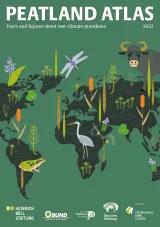
Huge areas of peatland around the world have already been destroyed. In the tropics, peat swamp forests are being cut down and the land drained. Fires and climate crisis also pose threats. Attempts to protect the peatlands have so far had little success.

Healthy peatlands around the world are being degraded at an alarming rate – through clearing, deforestation, slash-and-burn agriculture and drainage. Drained peatlands are used to establish fast-growing pulpwood or palm oil plantations, or for arable farming, pasture and forestry. Or they are subject to peat extraction or covered with buildings. Of the 500 million hectares of peatland worldwide, over 50 million have already been degraded to such an extent that peat can no longer accumulate, and remaining peat is under threat. Of the peatlands that are still accumulating peat, another 500,000 hectares are destroyed every year by human activities. In many fertile and easily accessible areas where human populations are growing, natural peatlands have been completely lost – as in central and eastern Europe and Southeast Asia. In the European Union, around half of all the peatlands have been drained. Most of the still-intact peatlands are found in thinly populated areas that are unsuited to agriculture – especially in the northern parts of the globe in Canada, Alaska, Siberia, and in inaccessible rainforest areas near the Equator, such as in the Congo and Amazon basins. Countries in Europe whose peatlands are considered to be well preserved include Sweden, Norway and Bosnia-Herzegovina. There they are 75 to 100 percent still intact.
Especially in the tropics, the destruction of peatlands is currently continuing, with catastrophic consequences. In these regions, the peatlands consist mostly of rainforest where massive trees grow on layers of peat that are metres thick. The trees offer shelter for orang-utans, forest elephants and many other species. Rainforests also store enormous quantities of carbon in their vegetation and in the soil. The most effective store is the peat itself. The tropical peatlands of Cuvette Central in the Democratic Republic of the Congo and the neighbouring Congo cover only 4 percent of the total area of the Congo Basin, but their peat stores around 30 billion tonnes of carbon, the same amount as in the rainforest vegetation of the entire basin.
Over half of the known tropical peatlands are found in Southeast Asia. Many of them are drained and degraded. Over the last 20 years, huge areas of peatlands have been converted to palm oil and acacia plantations, especially in Indonesia and Malaysia. The global production of palm oil has risen from 15 million tonnes in 1994 to over 74 million tonnes in 2019. This massive rise was permitted by the increasing use of palm oil as fuel, processed food and in washing and cleaning products. Acacia plantations, for their part, are used to produce pulp and paper.
Especially in Southeast Asia, uncontrolled, large-scale forest and ground fires have been blazing repeatedly since the 1990s. Under moist natural conditions, peat soils usually do not catch fire, but they burn well when they dry out. Big companies often set fires, either legally or illegally, to clear the land and create space for new plantations. Climate crisis has made many areas even more susceptible to forest fires. Indonesia has recently undertaken greater efforts to raise the water levels in its peatlands again. Its drained peatlands emit more greenhouse gases than any other country in the world. But in the meantime the government has set up a state agency for peat restoration and has already rewetted an area of over 2 million hectares.
Permafrost soils, which partly consist of frozen peat, are especially threatened by climate crisis. If they thaw, the organic matter they contain breaks down, releasing the carbon in form of the greenhouse gases carbon dioxide (CO₂) and methane (CH₄). In the Arctic, where most permafrost soils are found, the temperature has risen in the last 40 years almost four times faster than the global average.
In the Cuvette Centrale in the Congo Basin in Central Africa, which was scientifically recorded only a few years ago, the government of the Democratic Republic of Congo (DRC) has launched an oil and gas auction that would allow oil companies extensive licenses to exploit the area. With its area of 16.7 million hectares, the Cuvette Centrale is one of the largest contiguous areas of peatland worldwide. It includes more than one-third of the total area of all tropical peatlands, and contains more than a quarter of the carbon they store. If the oil auctions are not stopped, companies may be able to start chopping down trees, establishing palm oil plantations and drilling for oil there.

